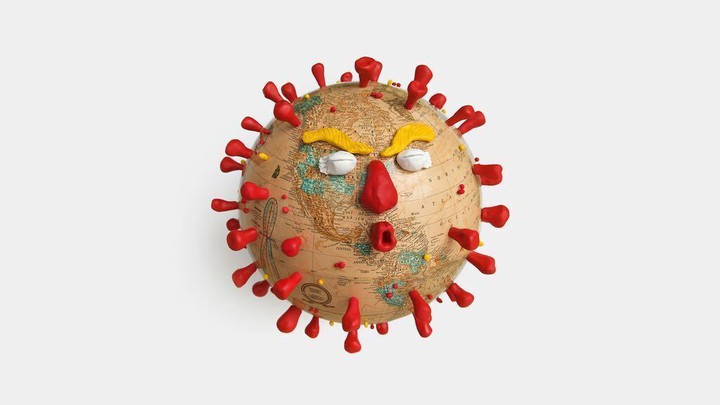It looks, at first, like one of a zillion unfunny video clips that now circulate on the internet: “Once Upon a Virus” features cheap animation, cheesy music, and sarcastic dialogue between China—represented by a Lego terra-cotta warrior with a low, masculine voice—and the United States, represented by a Lego Statue of Liberty with a high, squeaky voice. They “speak” in short sentences:
“We discovered a new virus,” says the warrior. “So what?” says the Statue of Liberty.
“It’s dangerous,” says the warrior. “It’s only a flu,” says the Statue of Liberty.
“Wear a mask,” says the warrior. “Don’t wear a mask,” says the Statue of Liberty.
“Stay at home,” says the warrior. “It’s violating human rights,” says the Statue of Liberty.
The dialogue goes on like that—“It will go away in April,” the Statue of Liberty says at one point—until it ends, finally, with the statue on an intravenous drip making wild and contradictory statements while the warrior jeers at her.
Although this looks like an I’m-bored-at-home amateur production, it is not: The video was published on April 30 by Xinhua, the official Chinese news agency. It has since been promoted by Chinese diplomats and watched, as of yesterday afternoon, by more than 1.6 million people around the world.
It has also been mocked and denounced as crude propaganda—which, of course, it is. Crude propaganda is what China’s leaders do, both at home and abroad, and since the pandemic began they have stepped up their efforts. But even those who are mocking should beware: Anybody who knows any history will be aware that propaganda—even the most obvious, most shameless propaganda—sometimes works. And it works not because people necessarily believe that all of it is true, but because they respect the capabilities or fear the power of the people who produced it.
Propaganda also works best in a vacuum, when there are no competing messages, or when the available alternative messengers inspire no trust. Since mid-March, China has been sending messages out into precisely this kind of vacuum: a world that has been profoundly changed not just by the virus, but by the American president’s simultaneously catastrophic and ridiculous failure to cope with it.
The tone of news headlines ranges from straight-faced in Kompas, a major Indonesian news outlet—“Trump Usulkan Suntik Disinfektan dan Sinar UV untuk Obati Covid-19,” or “Trump Proposes Disinfectant Injection and UV Rays to Treat COVID-19”—to snide, from Le Monde in France—“Les élucubrations du « docteur » Trump,” or “The Rantings of ‘Doctor’ Trump.” The incredulous first paragraph of an article in Sowetan, from South Africa, declares that “US President Donald Trump has again left people stunned and confused with his bizarre suggestion that disinfectant and ultraviolet light could possibly be used to treat Covid-19.” El Comercio, a distinguished Peruvian newspaper, treated its readers to photographs of Deborah Birx, the White House coronavirus-response coordinator, grimacing as the president asked her whether the injection of disinfectant might be a cure.
Quotations from the president’s astonishing April 23 press conference have appeared on every continent, via countless television channels, radio stations, magazines, and websites, in hundreds of thousands of variations and dozens of languages—often accompanied by warnings, in case someone was fooled, not to drink disinfectant or bleach. In years past, many of these outlets presumably published articles critical of this or that aspect of U.S. foreign policy, blaming one U.S. president or another. But the kind of coverage we see now is something new. This time, people are not attacking the president of the United States. They are laughing at him. Beppe Severgnini, one of Italy’s best-known columnists, told me that while Italians feel enormous empathy for Americans who have suffered as they have, they feel differently about Trump: “In this time of darkness and depression, he keeps us entertained.”
But if Trump is ridiculous, his administration is invisible. Carl Bildt—a Swedish prime minister in the 1990s, a United Nations envoy during the Bosnian wars, and a foreign minister for many years after that—told me that, looking back on his 30-year career, he cannot remember a single international crisis in which the United States had no global presence at all. “Normally, when something happens”—a war, an earthquake—“everybody waits to see what the Americans are doing, for better or for worse, and then they calibrate their own response based on that.”
This time, Americans are doing … nothing. Or to be more specific, because plenty of American governors, mayors, doctors, scientists, and tech companies are doing things, the White House is doing nothing. There is no presidential leadership inside the United States; there is no American leadership in the world. Members of the G7—the U.S. and its six closest allies—did meet to write a joint statement. But even that tepid project ended in ludicrous rancor when the American secretary of state, Mike Pompeo, insisted on using the expression “Wuhan virus” and the others gave up in disgust. Not only is the president talking nonsense, not only is America absent, but the nation’s top diplomat is a caricature of a tough guy—someone who throws around insults in the absence of any capacity to influence events.
Others are drawing even more radical conclusions, and with remarkable speed. The “disinfectant” comments—and the laughter that followed—mark not so much a turning point as an acceleration point, the moment when a transformation that began much earlier suddenly started to seem unstoppable. Although we are still only weeks into this pandemic, although the true scale of the health crisis and the economic catastrophe is still unknown, the outline of a very different, post-American, post-coronavirus world is already taking shape. It’s a world in which American opinions will count less, while the opinions of America’s rivals will count more. And that will change political dynamics in ways that Americans haven’t yet understood.
Look beyond the Lego video at China’s more serious public-relations campaign: the stunts at airports around the world, from Pakistan to Italy to Israel, designed to mark the arrival of Chinese aid—masks, surgical gowns, diagnostic tests, and sometimes doctors. These events all have a similar script: The plane lands; the receiving nation’s dignitaries go out to meet it; the Chinese experts emerge, looking competent in their hazmat gear; and everyone utters words of gratitude and relief. Of course some of this, too, is propaganda.
In reality, some of the equipment billed as aid has been purchased, not donated. Some of it, especially the diagnostic tests, has turned out to be defective. Some of those who receive these goods also know perfectly well that they are designed to silence questions about where the virus came from, why knowledge of it was initially suppressed, and why it was allowed to spread around the world. If, in these circumstances, the propaganda “works,” that’s because those who receive it have made a calculation: Pretending to believe it is a way of acknowledging and accepting Chinese power—and, perhaps, a way of expressing interest in Chinese investment.Read: Why the coronavirus is so confusing.
In the Western world, this dynamic has played itself out with striking success in Italy. Flattened by the virus and depressed by the lockdown, Italians are deeply divided by years of conspiratorial social-media campaigns, some with Russian backing, that have attacked Italy’s traditional alliances, NATO as well as the European Union. China has added its own unsubtle social-media campaign. Bots have been promoting Chinese-Italian-friendship hashtags (#forzaCinaeItalia) and thank-you-China hashtags (#grazieCina). But there is another, less visible layer of activity, too.
Thanks to the economic havoc created by the coronavirus, China’s efforts in Rome may now bear fruit. Maurizio Molinari, the editor of La Repubblica, told me that Chinese businessmen are right now building on their contacts, looking for companies and properties to buy, scouting out factories that are suddenly bankrupt and entrepreneurs who want to sell out. I asked him what the source of China’s appeal was right now: “Money,” he replied. By contrast, the most conspicuous gesture that the U.S. administration has made in Italy’s direction since the pandemic began was Trump’s abrupt decision to ban flights. Apart from a modest and belated aid package, little in the way of friendship came from the United States.
China’s relationships with the Arab world have also deepened during the pandemic. Qatar, Saudi Arabia, and Kuwait sent aid to Wuhan during the earlier part of the crisis; later, China reciprocated. The foreign minister of the United Arab Emirates has described China as the role model to follow in this crisis. On March 8, Chinese medical workers arrived in Baghdad—an advance team, perhaps, poised to take advantage of the inevitable American retreat. In each one of these places, America is absent, distracted, stumbling—and laughable.




Average Rating